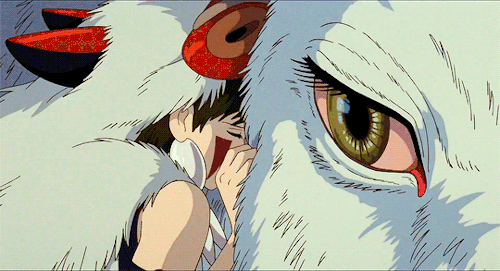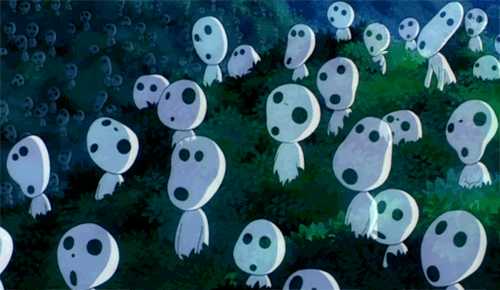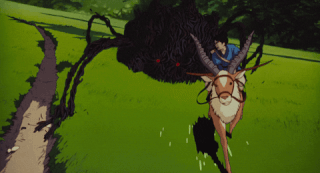

The amount of talent it takes to get a message across such as environmentalism, without being too “preachy” that it annoys viewers, must be exponential. As an advocate for nature, I personally don’t mind a message that’s blunt and to the point. As long as at least one person gets the intended message. Though that’s not to say that I can’t appreciate a more nuanced approach. In fact, I’d argue that it’s this method that appeals to most and doesn’t turn people off. Leave it to Studio Ghibli to craft a beautiful work of art that harpoons its pro-environmental message into the viewer’s hearts and minds unbeknownst to them. How did Ghibli manage to execute this task so seamlessly, and how much does it stand on its own as a standalone film without my biased opinion of its message?
In this film we follow Ashitaka, a young man who’s one of the few remaining Emishi (a well respected tribe of its time) who gets cursed while fending off an angry boar from pillaging his village. An elder of his tribe tells him that this curse will kill him soon. Though there is a possible cure deep in the forest. And during his trek we find out who has the ability to heal Ashitaka, why the boar went berserk, and the various factions of humans, animals, and spirits fighting for control over the forest. I will not spoil every iota detail of the story like I normally do, as I strongly encourage everyone to see this film, but I do plan on touching on some aspects of the story that I feel the need to either commemorate or critique that go in tandem with certain crucial plot points. Though do not fret, I will give a warning when necessary.

The flow of the story’s events are phenomenally paced. Having the most gripping opening of an anime film I’ve seen to date. Though the first few shots we see are beautiful, calm, and peaceful, it’s not long before we’re thrown straight into action. With the boar, being controlled by a demon filled with visceral hatred towards humans. Shown not only through his dialogue but also as a physical manifestation), battling Ashitaka as his tentacles (or demon follicles as I like to call them) jitter and reverberate as the sun’s light hits the boar’s body. This opening gets straight to the point and shows Ghibli knows how to make their beauty accentuate both the peacefulness and ferocity of the wild in the exact same scene. The action and animation of this scene (and just about every scene for that matter) is smooth, beautiful, gruesome, and attention grabbing without coming off as trying to over exert itself or the audience, which is something this film as a whole excels at, especially in the message. But more on that in a bit.
As with most Ghibli films, the visuals, aesthetic and animation alone are worthy of making this film a 10/10, as there’s not a single frame of this film that’s not worthy of being framed in an exhibit. But it goes above and beyond its visuals to enhance the viewer’s immersion. The score for this film is epic, soothing, and invigorating depending on the scene. That’s no surprise given that the film’s score was composed by one of the most talented Orchestra band’s of all time. The only downside I had with the audio department of the film was the effects used on some of the animal’s/god’s voices such as the apes, boars, and even San’s mom to an extent. As I felt that the effects given to their voices felt cheap compared to how grand their appearance was, I know it was a different time and the technology for editing audio was not as advanced, and that this is a minor nitpick at most, but I could pull off the same vocal effects in audacity in less than 5 minutes. But honestly, that sorta thing adds to this movie’s charm and whimsical nature.

Another aspect of the film that adds to its whimsical nature are the characters. The protagonist, Ashitaka, is a determined, good natured, well-disciplined and mature young man who places the safety of those around him in front of himself, despite his main goal. The boy is not perfect, as there are many points where the curse of the demon almost gets the better of his temperament and leads him to wanting to inflict pain on those with morals that don’t align with his, namely Eboshi. Speaking of which, Eboshi serves as the main antagonist of the film despite not being shown to be an inherently malicious person, but as someone doing what she considers to be a necessary evil to better the lives of her village. With the help of a shady businessman/self-proclaimed monk, Jigo, she sets out to industrialize her village through gathering iron, which destroys the forest and makes the Mononoke-hime/animals/forest gods despise humans. And the last notable character is Mononoke-hime herself who was raised by the Wolf-god after her parents abandoned her and she now defends the forest from humans, doesn’t consider herself one, and aims to kill eboshi and even Ashitaka.
The characters are all well written, and interesting to follow and see develop. The only gripe I have in this department has to do with the character Jigo. This guy is such an enigma for better or worse. It’s never clear cut what his goals are (aside from becoming more powerful I presume?) and or even what he is. Well, he’s a human yes, but sometimes he appears as a mere wanderer and other times he’s commanding an entire fleet of foot soldiers to directly assist Eboshi (one of if not the highest ranking human character in the story). I also wish we got to learn more about the elusive Emishi tribe, Ashitaka’s history, and various other tidbits about the world and characters in this story that aren’t touched on aside from a couple scenes they get. But that’s the case with most Ghibli films. Giving you an amazing world to experience only a fraction of, leaving you wanting more, craving more knowledge.

Lastly, (minor spoilers ahead) the film ends with the sentiment that we need to treat nature with respect, and if we are to take from the world then we are to give it something good in return to maintain balance. Nature won’t always be graceful, but without nature, both its inhabitants and humans living outside of it won’t survive unless there’s a symbiotic relationship. The film doesn’t expect, or want you to become someone like San(Mononoke-san) who hates humans for how they treat nature and it also wants you to avoid becoming an Eboshi who doesn’t care about the long-lasting impact of her actions. If anything, it’s saying be like Ashitaka who sees the necessity and merit of both sides. And understand that each side needs each other to survive and flourish, through human prosperity with industrialization/technological progression and nature’s ability to keep life on Earth alive and stable.
Princess Mononoke is a film that I implore everyone to watch as it’s one of the rare examples of a film that is not only a beautiful film with an amazing message, but executes its message in such a way that makes you have to think. And if you don’t want to use your brain, then feel free to turn it off and let the raw beauty of this film compel you, with its amazing visuals, voice acting, and score. Though there are moments that do feel slow, and there are characters and bits that I wish were explored deeper, that does not take away from the awe-inspiring presentation of this film.
